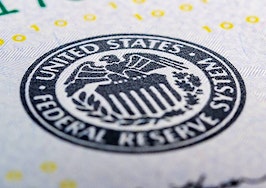Earthquake potential is high this week. Unlike scientists in California, we often know exactly when it will hit, just not the magnitude. The Fed will complete its July meeting on Wednesday, and at dawn on Friday, we’ll learn employment stats for July. Put the wine bottles on their sides, other crockery on the floor, and on those days perhaps plan to be outdoors.
While waiting, a broad scale review.
Last week’s release of 2nd quarter GDP found 2.1 percent growth year-over-year and the usual quarter-to-quarter data wobbles. The two main things: Consumer spending has continued to grow near 4 percent annualized, which may or may not be sustainable given unsustainable 5 percent growth in government spending. Rates unchanged, the 10-year T-note at 2.07 percent, mortgages 4 percent.

This week’s Eurozone data were horrible. The overall manufacturing purchasing managers’ survey (PMI) for July dropped down to 46.4 from 47.6 — 44 is the marker of recession. Germany’s PMI fell from 45 to 43.1. The European Central Bank (ECB) came through with rhetorical thunder about new stimulus to come, including likely resumption of QE bond-buying. As in previous rounds of ECB stimulus, markets are buying the things which the ECB will buy, not taking risks; markets believe stimulus is coming but don’t think it will work.
On a side note, given this economic and governance performance, why would Britain not want to exit the EU? Britain is by itself the world’s fifth-largest economy, doing fine thank you, while Europe deludes itself to disaster. If it is so hard to get permission to leave, all the more reason to get away from the sinking ship. Two Brexit things lost on U.S. observers: The EU’s odious effort to trap Britain by insisting on a post-exit hard border between Ireland and the North, its open status key to ending The Troubles; and second, the grotesque pro-EU propaganda that Boris Johnson is Trump with a different accent.
U.S. rates fell briefly on the expected ECB announcements, but then rose upon release of a lovely report of U.S. orders for durable goods surging 2 percent and roughly quadruple the forecast. Orders for core capital goods, the muscle for future expansion and productivity, exploded upward. Sales of new and existing homes are steady. The Fed will struggle to explain the need for more cuts after Wednesday.
The U.S.-created trade war is hurting the outside world. How goes that war? U.S. imports and exports in June both fell in similar amounts, and very hard, 2 percent in the month alone. But we feel no pain — we are the least-dependent on trade of any major nation. Both import and export prices are falling fast, year-over-year 2 percent and 1.6 percent respectively. Which likely means that importers are not paying tariffs and adding them to prices, just moving sourcing somewhere else, the disrupted supply chains hurting everyone else.
If this trade war is no benefit to the U.S., and damages everyone else, and we look to the Fed to cut rates in case everyone else’s troubles wash ashore here… why fight the war?
Who gets credit for the good U.S. economy? Everyone and no one. Our economy, for a couple of centuries, has been the world’s most adaptable, and we thrive in this era of globalization and IT disruption. We are assisted by a cheap and porous safety net abhorred by Europeans, and a light-touch Federal government compared to any other.
Our politics do matter, especially in the matter of debt and the linked needs for health coverage for all, but cost-reduced, and to limit the growth of entitlements. A new NPR/PBS Marist poll last week is the most useful in my memory. It asked self-identified Democrats, Republicans, and Independents separately their views on leading issues. See graphic on NPR. Gallup has found 24 percent of us to be Republicans, 31 percent Democrats, and 41 percent Independents. If we strip out the moderates in each party, the two more extreme wings controlling each party combined are fewer than the Independents, for whom no one speaks.
Message to overconfident Democrats: the NPR poll predictably found Independents opposed to Mr. Trump 54 percent to 33 percent. But asked if Democrats would take the country in the right direction, 48 percent to 40 percent of Independents also said “Uh-uh.” Far-left Democrats beware: The more the center sees of your candidates, the less it likes you.
Within each of the two parties, the extreme versus moderate divide may be as big as the historical Left vs. Right divide in the whole electorate.
So, shift the scene once again to humanity for comic relief. Last week, The Wall Street Journal hit a human nature trifecta in its Tuesday issue alone:
1. China’s retaliatory tariffs have chopped U.S. cotton prices by 30 percent, but without political effect here. “’I haven’t heard anyone start cussing Trump about these tariffs,’ said Billy Don Hinkle, who grows 6,000 acres in Aubrey, Arkansas.” Um… we should expect China to be less stubborn than we are?
2. In an editorial, Pete Coors complained about unfairness in the aluminum market. He is vice-chair of Molson Coors, his family for generations among the most conservative Americans and heavy contributors to the anti-government cause. Coors: “It now is clear that government intervention and oversight are necessary.” We all have our principles, but sometimes they are flexible.
3. Ford’s results in China have tanked 27 percent in the first six months of 2019. Ford’s China chief said, “We probably didn’t realize that the market was moving very fast.” Why change the 60-year run of failed Detroit-think? If we wish to do well in foreign trade, be good at it.













